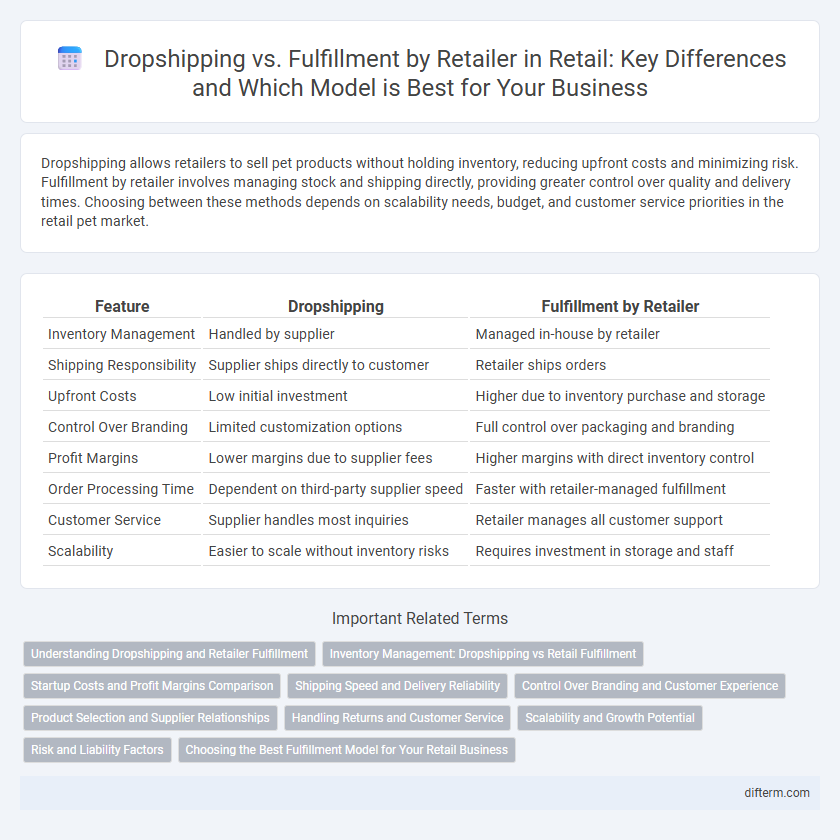Dropshipping allows retailers to sell pet products without holding inventory, reducing upfront costs and minimizing risk. Fulfillment by retailer involves managing stock and shipping directly, providing greater control over quality and delivery times. Choosing between these methods depends on scalability needs, budget, and customer service priorities in the retail pet market.
Table of Comparison
| Feature | Dropshipping | Fulfillment by Retailer |
|---|---|---|
| Inventory Management | Handled by supplier | Managed in-house by retailer |
| Shipping Responsibility | Supplier ships directly to customer | Retailer ships orders |
| Upfront Costs | Low initial investment | Higher due to inventory purchase and storage |
| Control Over Branding | Limited customization options | Full control over packaging and branding |
| Profit Margins | Lower margins due to supplier fees | Higher margins with direct inventory control |
| Order Processing Time | Dependent on third-party supplier speed | Faster with retailer-managed fulfillment |
| Customer Service | Supplier handles most inquiries | Retailer manages all customer support |
| Scalability | Easier to scale without inventory risks | Requires investment in storage and staff |
Understanding Dropshipping and Retailer Fulfillment
Dropshipping allows retailers to sell products without holding inventory, as suppliers ship directly to customers, reducing upfront costs and inventory risks. Retailer fulfillment involves managing stock, packing, and shipping internally, offering greater control over inventory and customer experience. Choosing between dropshipping and retailer fulfillment depends on factors like capital, inventory control, and delivery speed.
Inventory Management: Dropshipping vs Retail Fulfillment
Dropshipping eliminates the need for retailers to hold inventory, relying instead on suppliers to ship products directly to customers, which reduces overhead costs but limits control over stock levels and delivery times. In contrast, fulfillment by retailer involves managing inventory in-house or through third-party warehouses, offering greater control over stock availability, quality checks, and faster shipping options. Effective inventory management in retail fulfillment demands robust demand forecasting and real-time stock tracking to minimize stockouts and overstock situations.
Startup Costs and Profit Margins Comparison
Dropshipping requires minimal startup costs since inventory storage and shipping are managed by suppliers, allowing retailers to avoid upfront investment in stock. Fulfillment by retailer involves higher initial expenses for warehousing, inventory purchase, and logistics setup but offers greater control over product quality and customer experience. Profit margins in dropshipping tend to be lower due to supplier fees and competitive pricing, whereas fulfillment by retailer can yield higher margins by eliminating intermediaries and optimizing pricing strategies.
Shipping Speed and Delivery Reliability
Dropshipping often results in slower shipping speeds and less predictable delivery reliability due to reliance on third-party suppliers and multiple shipping points. Fulfillment by retailer enhances shipping speed with direct inventory control and streamlined logistics, ensuring consistent and faster delivery times. Retailers managing their own fulfillment can better guarantee package tracking accuracy, reducing delivery failures and improving customer satisfaction.
Control Over Branding and Customer Experience
Dropshipping limits control over branding and customer experience as products ship directly from third-party suppliers, resulting in inconsistent packaging and delayed communication. Fulfillment by retailer enables full oversight of packaging design, quality checks, and direct interaction with customers, enhancing brand consistency and satisfaction. Retailers maintaining fulfillment can tailor the unboxing experience, reinforcing brand identity and fostering customer loyalty.
Product Selection and Supplier Relationships
Dropshipping relies on third-party suppliers to handle inventory and shipping, allowing retailers to offer a wide range of products without upfront stock investment, but limits control over product quality and delivery times. Fulfillment by retailer involves maintaining inventory in-house or through dedicated warehouses, enabling strict oversight of product selection and customization, resulting in higher customer satisfaction and brand consistency. Strong supplier relationships in dropshipping require rigorous vetting and ongoing communication, whereas fulfillment by retailer demands close coordination with manufacturers and logistics partners to optimize stock levels and reduce fulfillment errors.
Handling Returns and Customer Service
In retail, dropshipping shifts the responsibility of handling returns and customer service to the supplier, often resulting in longer resolution times and less control over customer experience. Fulfillment by retailer allows direct management of returns, enabling faster processing and personalized customer support, which enhances satisfaction and brand loyalty. Efficient return policies and responsive service are critical for retailers to maintain competitive advantage and improve overall customer lifetime value.
Scalability and Growth Potential
Dropshipping offers high scalability with minimal upfront investment, enabling retailers to expand product offerings without handling inventory or logistics, accelerating market entry and reducing financial risk. Fulfillment by retailer requires greater capital and operational capacity but provides enhanced control over inventory, shipping quality, and customer experience, which supports sustainable growth and brand loyalty. Retailers prioritizing rapid expansion often favor dropshipping, while those focused on long-term brand development and margin optimization may invest in their own fulfillment systems.
Risk and Liability Factors
Dropshipping minimizes inventory risk since the retailer does not hold stock but increases liability exposure due to reliance on third-party suppliers for product quality and delivery. Fulfillment by retailer involves greater inventory management risk but offers stronger control over shipping accuracy, product condition, and customer service, reducing liability issues. Choosing between the two depends on balancing operational risk tolerance with the need for accountability in the retail supply chain.
Choosing the Best Fulfillment Model for Your Retail Business
Choosing the best fulfillment model for your retail business depends on factors such as inventory control, shipping speed, and profit margins. Dropshipping minimizes upfront investment by outsourcing inventory management and shipping to suppliers, while fulfillment by retailer provides greater control over stock quality and customer experience. Evaluating sales volume, operational capacity, and customer expectations will help determine whether dropshipping or direct fulfillment aligns better with your business goals.
Dropshipping vs Fulfillment by retailer Infographic

 difterm.com
difterm.com